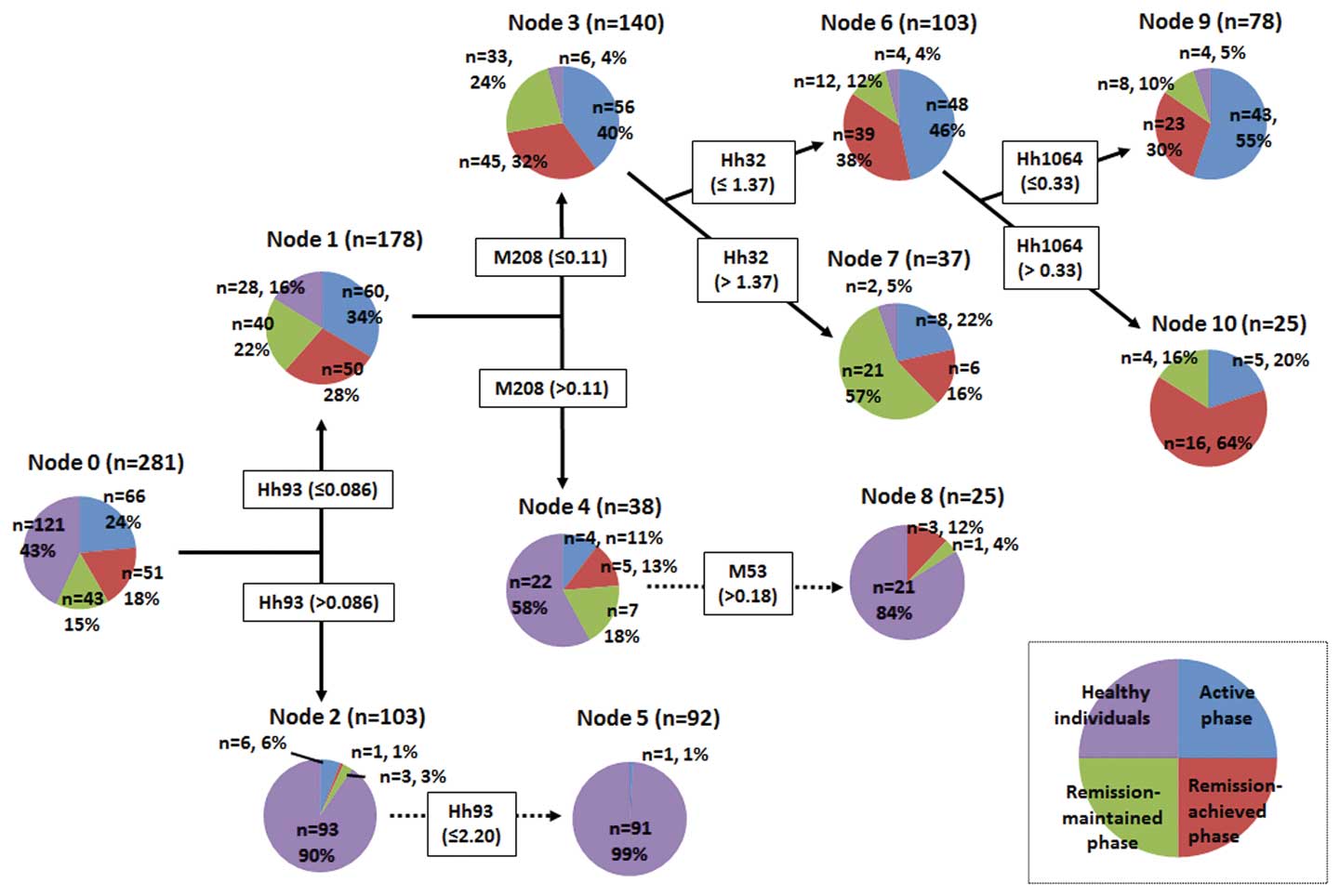|
1
|
Mayer L: Evolving paradigms in the
pathogenesis of IBD. J Gastroenterol. 45:9–16. 2010. View Article : Google Scholar
|
|
2
|
Podolsky DK: Inflammatory bowel disease. N
Engl J Med. 347:417–429. 2002. View Article : Google Scholar
|
|
3
|
Ueno F, Matsui T, Matsumoto T, Matsuoka K,
Watanabe M and Hibi T; Guidelines Project Group of the Research
Group of Intractable Inflammatory Bowel Disease subsidized by the
Ministry of Health, Labour and Welfare of Japan and the Guidelines
Committee of the Japanese Society of Gastroenterology.
Evidence-based clinical practice guidelines for Crohn’s disease,
integrated with formal consensus of experts in Japan. J
Gastroenterol. 48:31–72. 2013.
|
|
4
|
Imaeda H, Andoh A and Fujiyama Y:
Development of a new immunoassay for the accurate determination of
anti-infliximab antibodies in inflammatory bowel disease. J
Gastroenterol. 47:136–143. 2012. View Article : Google Scholar : PubMed/NCBI
|
|
5
|
Sartor RB: Microbial influences in
inflammatory bowel diseases. Gastroenterology. 134:577–594. 2008.
View Article : Google Scholar : PubMed/NCBI
|
|
6
|
Mizoguchi A and Mizoguchi E: Inflammatory
bowel disease, past, present and future: lessons from animal
models. J Gastroenterol. 43:1–17. 2008. View Article : Google Scholar : PubMed/NCBI
|
|
7
|
Sartor RB: Mechanisms of disease:
pathogenesis of Crohn’s disease and ulcerative colitis. Nat Clin
Pract Gastroenterol Hepatol. 3:390–407. 2006.
|
|
8
|
Hamilton MJ, Snapper SB and Blumberg RS:
Update on biologic pathways in inflammatory bowel disease and their
therapeutic relevance. J Gastroenterol. 47:1–8. 2012. View Article : Google Scholar : PubMed/NCBI
|
|
9
|
Wirtz S and Neurath MF: Mouse models of
inflammatory bowel disease. Adv Drug Deliv Rev. 59:1073–1083. 2007.
View Article : Google Scholar : PubMed/NCBI
|
|
10
|
Braun J and Wei B: Body traffic: ecology,
genetics, and immunity in inflammatory bowel disease. Annu Rev
Pathol. 2:401–429. 2007. View Article : Google Scholar : PubMed/NCBI
|
|
11
|
Seksik P, Sokol H, Lepage P, et al: Review
article: the role of bacteria in onset and perpetuation of
inflammatory bowel disease. Aliment Pharmacol Ther. 24(Suppl 3):
11–18. 2006. View Article : Google Scholar : PubMed/NCBI
|
|
12
|
Elson CO, Cong Y, McCracken VJ, Dimmitt
RA, Lorenz RG and Weaver CT: Experimental models of inflammatory
bowel disease reveal innate, adaptive, and regulatory mechanisms of
host dialogue with the microbiota. Immunol Rev. 206:260–276. 2005.
View Article : Google Scholar : PubMed/NCBI
|
|
13
|
Frank DN, St Amand AL, Feldman RA,
Boedeker EC, Harpaz N and Pace NR: Molecular-phylogenetic
characterization of microbial community imbalances in human
inflammatory bowel diseases. Proc Natl Acad Sci USA.
104:13780–13785. 2007. View Article : Google Scholar
|
|
14
|
Andoh A, Kuzuoka H, Tsujikawa T, et al:
Multicenter analysis of fecal microbiota profiles in Japanese
patients with Crohn’s disease. J Gastroenterol. 47:1298–1307.
2012.PubMed/NCBI
|
|
15
|
Kuwahara E, Asakura K, Nishiwaki Y, et al:
Effects of family history on inflammatory bowel disease
characteristics in Japanese patients. J Gastroenterol. 47:961–968.
2012. View Article : Google Scholar : PubMed/NCBI
|
|
16
|
Imaeda H, Bamba S, Takahashi K, et al:
Relationship between serum infliximab trough levels and endoscopic
activities in patients with Crohn’s disease under scheduled
maintenance treatment. J Gastroenterol. May 11–2013.(Epub ahead of
print).
|
|
17
|
Nagalingam NA and Lynch SV: Role of the
microbiota in inflammatory bowel diseases. Inflamm Bowel Dis.
18:968–984. 2012. View Article : Google Scholar : PubMed/NCBI
|
|
18
|
Andoh A, Imaeda H, Aomatsu T, et al:
Comparison of the fecal microbiota profiles between ulcerative
colitis and Crohn’s disease using terminal restriction fragment
length polymorphism analysis. J Gastroenterol. 46:479–486.
2011.
|
|
19
|
Atarashi K, Tanoue T, Shima T, et al:
Induction of colonic regulatory T cells by indigenous
Clostridium species. Science. 331:337–341. 2011. View Article : Google Scholar : PubMed/NCBI
|
|
20
|
Sokol H, Pigneur B, Watterlot L, et al:
Faecalibacterium prausnitzii is an anti-inflammatory
commensal bacterium identified by gut microbiota analysis of Crohn
disease patients. Proc Natl Acad Sci USA. 105:16731–16736. 2008.
View Article : Google Scholar
|
|
21
|
Sokol H, Seksik P, Furet JP, et al: Low
counts of Faecalibacterium prausnitzii in colitis
microbiota. Inflamm Bowel Dis. 15:1183–1189. 2009.
|
|
22
|
Fujimoto T, Imaeda H, Takahashi K, et al:
Decreased abundance of Faecalibacterium prausnitzii in the
gut microbiota of Crohn’s disease. J Gastroenterol Hepatol.
28:613–619. 2013.
|
|
23
|
Best WR, Becktel JM, Singleton JW and Kern
F Jr: Development of a Crohn’s disease activity index. National
Cooperative Crohn’s Disease Study. Gastroenterology. 70:439–444.
1976.
|
|
24
|
Hayashi H, Sakamoto M, Kitahara M and
Benno Y: Diversity of the Clostridium coccoides group in
human fecal microbiota as determined by 16S rRNA gene library. FEMS
Microbiol Lett. 257:202–207. 2006.
|
|
25
|
Matsumoto M, Sakamoto M, Hayashi H and
Benno Y: Novel phylogenetic assignment database for
terminal-restriction fragment length polymorphism analysis of human
colonic microbiota. J Microbiol Methods. 61:305–319. 2005.
View Article : Google Scholar
|
|
26
|
Sakamoto M, Takeuchi Y, Umeda M, Ishikawa
I and Benno Y: Application of terminal RFLP analysis to
characterize oral bacterial flora in saliva of healthy subjects and
patients with periodontitis. J Med Microbiol. 52:79–89. 2003.
View Article : Google Scholar : PubMed/NCBI
|
|
27
|
Marsh TL, Saxman P, Cole J and Tiedje J:
Terminal restriction fragment length polymorphism analysis program,
a web-based research tool for microbial community analysis. Appl
Environ Microbiol. 66:3616–3620. 2000. View Article : Google Scholar : PubMed/NCBI
|
|
28
|
Blair YI, McMahon AD and Macpherson LM:
Comparison and relative utility of inequality measurements: as
applied to Scotland’s child dental health. PLoS One.
8:e585932013.PubMed/NCBI
|










